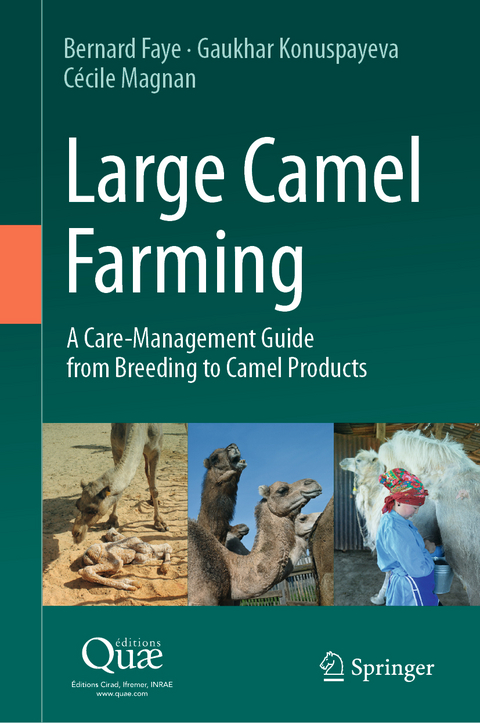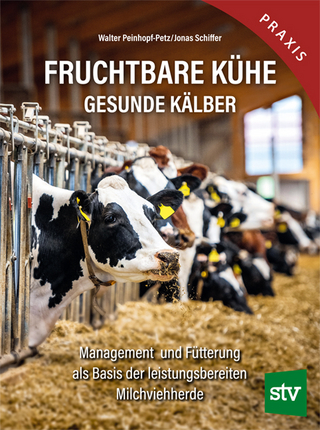
Large Camel Farming
Springer (Verlag)
978-94-024-2236-8 (ISBN)
Large camels (camels and Bactrian camels) are domestic animals that are increasingly used in Western countries, as well as in Africa and Asia, for tourism, sport, and production of milk, meat, and wool. In addition, camel husbandry systems are changing, taking a greater share of sedentary systems, specializing in breeding, and intensifying production. At the same time, many veterinarians and breeders are not familiar with the animal, its needs, physiology, diseases, and management, which is often based on practicesintroduced for cattle and proving ineffective.
This work is a practical aid for all interested readers who want to embark on the adventure of working with large camelids in a cultural context where they are not yet a dominant element of the agricultural landscape. The numerous photographs and drawings that support the text make it a unique and entertaining read.
Dr. Bernard Faye, veterinarian and doctor of the University PARIS XII, is an INRA research engineer and currently emeritus expert at CIRAD. As a specialist in camel breeding and production he brings more than 40 years of experience with this species. He is author of the “Guide de l'élevage du dromadaire” (Ed. SANOFI, 1997), of “Bergers du monde” (Ed. QUAE and E&C, 2008), and contributor to the “Dromadaire pédagogique” (Ed. CIRAD-Les Savoirs partagés, 2002). Bernard further co-authored “Camel Clinical Biochemistry and Hematology” (Ed. Springer, 2018). Prof. Gaukhar Konuspayeva (Al-Farabi University in Almaty, Kazakhstan), is a biochemist and doctor of the University of Montpellier. She serves as a consultant for FAO and has been a visiting researcher at CIRAD. Gaukhar is a specialist in camel milk and -processing. The present book has greatly benefited from her contribution on the processing of dairy products. Dr. Cécile Magnan is a veterinary doctorand equine specialty practitioner committed to the protection of circus animals. As such, Cécile has extensive experience in the care to be given to large camelids of which she keeps some specimens on her own farm transformed into a retirement home for old circus animals. Her contribution to this volume has been decisive on the aspects of health management.
Chapter 1: General information on large camelids in the world: Origin, taxonomy, biodiversity, and new settlements.- Chapter 2: Anatomical features of large camelids.- Chapter 3: Physiology of large camelids: Life cycle, adaption to ecosystems, and reproduction.- Chapter 4: The physiological basis of large camelid lactation, digestion, and nutrition.- Chapter 5: Technical management of a camel farm with a focus on dairy: Breeding and young animal rearing, milking, and feeding.- Chapter 6: Animal health management and veterinary practices in a camel farm.- Chapter 7: Economic management of a dairy camel farm.- Chapter 8: Camel products and services: From dairy-, meat and non-food products to riding and transport, including slaughter.
| Erscheinungsdatum | 15.12.2023 |
|---|---|
| Zusatzinfo | 178 Illustrations, color; 12 Illustrations, black and white; XVII, 207 p. 190 illus., 178 illus. in color. |
| Verlagsort | Dordrecht |
| Sprache | englisch |
| Maße | 155 x 235 mm |
| Themenwelt | Naturwissenschaften ► Biologie ► Zoologie |
| Veterinärmedizin ► Klinische Fächer | |
| Veterinärmedizin ► Großtier | |
| Weitere Fachgebiete ► Land- / Forstwirtschaft / Fischerei | |
| Schlagworte | Camel Management • Camel Physiology • Camel Production • Camel Products • Large Camelids |
| ISBN-10 | 94-024-2236-6 / 9402422366 |
| ISBN-13 | 978-94-024-2236-8 / 9789402422368 |
| Zustand | Neuware |
| Haben Sie eine Frage zum Produkt? |
aus dem Bereich


